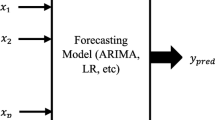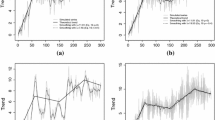Abstract
Modeling of financial time series data by methods of artificial intelligence is difficult because of the extremely noisy nature of the data. A common and simple form of filter to reduce the noise originated in signal processing, the finite impulse response (FIR) filter. There are several of these noise reduction methods used throughout the financial instrument trading community. The major issue with these filters is the delay between the filtered data and the noisy data. This delay only increases as more noise reduction is desired. In the present marketplace, where investors are competing for quality and timely information, this delay can be a hindrance. This paper proposes a new FIR filter derived with the aim of maximizing the level of noise reduction and minimizing the delay. The model is modified from the old problem of time series graduation by penalized least squares. Comparison between five different methods has been done and experiment results have shown that our method is significantly superior to the alternatives in both delay and smoothness over short and middle range delay periods.
Access this chapter
Tax calculation will be finalised at checkout
Purchases are for personal use only
Preview
Unable to display preview. Download preview PDF.
Similar content being viewed by others
References
Boudraa, A.O., Cexus, J.C.: EMD-based signal filtering. IEEE Transactions on Instrumentation and Measurement 56(6), 2196–2202 (2007)
Donoho, D.L., Johnstone, I.M.: Adapting to unknown smoothness via wavelet shrinkage. Journal of the American Statistical Association 90(432), 1200–1224 (1995)
Donoho, D.L., Johnstone, I.M.: Minimax estimation via wavelet shrinkage. The Annals of Statistics 26(3), 879–921 (1998)
Drakakis, K.: Empirical mode decomposition of financial data. International Mathematical Forum 3(25), 1191–1202 (2008)
Ehlers, J.F.: Rocket science for traders: Digital signal processing applications. John Wiley & Sons, Inc., New York (2001)
Eilers, P.H.C.: A perfect smoother. Analytical Chemistry 75(14), 3631–3636 (2003)
Ellis, C.A., Parbery, S.A.: Is smarter better? a comparison of adaptive, and simple moving average trading strategies. Research in International Business and Finance 19(3), 399–411 (2005)
Farmer, D.J., Sidorowich, J.J.: Optimal shadowing and noise reduction. Physica D: Nonlinear Phenomena 47(3), 373–392 (1991)
Gardner, J.E.S.: Exponential smoothing: The state of the art–part II. International Journal of Forecasting 22(4), 637–666 (2006)
Godsill, S.J., Doucet, A., West, M.: Monte Carlo smoothing for nonlinear time series. Journal of the American Statistical Association 99(465), 156–168 (2004)
Hale, D.: Recursive gaussian filters. Tech. rep., Center for Wave Phenomena (2006)
Hassani, H.: Singular spectrum analysis: Methodology and comparison. Journal of Data Sciences 5, 239–257 (2007), mPRA Paper
Hassani, H., Soofi, A.S., Zhigljavsky, A.A.: Predicting daily exchange rate with singular spectrum analysis. Nonlinear Analysis: Real World Applications 11(3), 2023–2034 (2010)
Hodrick, R.J., Prescott, E.C.: Postwar u.s. business cycles: An empirical investigation. Journal of Money, Credit and Banking 29(1), 1–16 (1997)
Hsu, L.-Y., Horng, S.-J., He, M., Fan, P., Kao, T.-W., Khan, M.K., Run, R.-S., Lai, J.-L., Chen, R.-J.: Mutual funds trading strategy based on particle swarm optimization. Expert Systems with Applications 38(6), 7582–7602 (2011)
Hull, A.: Hull moving average HMA (2011), http://www.justdata.com.au/Journals/AlanHull/hull_ma.htm
Kalman, R.E.: A new approach to linear filtering and prediction problems. Transactions of the ASME Journal of Basic Engineering 82(Series D), 35–45 (1960)
Kamen, E.W., Su, J.K.: Introduction to optimal estimation. Springer, London (1999)
Karunasingha, D.S.K., Liong, S.Y.: Enhancement of chaotic time series prediction with real-time noise reduction. In: International Conference on Small Hydropower - Hydro Sri Lanka (2007)
Klaas, M., Briers, M., Freitas, N.d., Doucet, A., Maskell, S., Lang, D.: Fast particle smoothing: if I had a million particles. In: Proceedings of the 23rd International Conference on Machine Learning, pp. 481–488 (2006)
Kostelich, E.J., Yorke, J.A.: Noise reduction in dynamical systems. Physical Review A 38(3), 1649 (1988)
Kostelich, E.J., Yorke, J.A.: Noise reduction: Finding the simplest dynamical system consistent with the data. Physica D: Nonlinear Phenomena 41(2), 183–196 (1990)
Legoux, A.: ALMA Arnaud Legous Moving Average (2009), http://www.arnaudlegoux.com/wp-content/uploads/2011/03/ALMA-Arnaud-Legoux-Moving-Average.pdf (2011)
Li, T., Li, Q., Zhu, S., Ogihara, M.: A survey on wavelet applications in data mining. SIGKDD Explor. Newsl. 4(2), 49–68 (2002), 772870
Liu, Y., Liao, X.: Adaptive chaotic noise reduction method based on dual-lifting wavelet. Expert Systems with Applications 38(3), 1346–1355 (2011)
Moore, J.B.: Discrete-time fixed-lag smoothing algorithms. Automatica 9(2), 163–173 (1973)
Nikpour, M., Nadernejad, E., Ashtiani, H., Hassanpour, H.: Using pde’s for noise reduction in time series. International Journal of Computing and ICT Research 3(1), 42–48 (2009)
Russell, S.J., Norvig, P.: Artificial intelligence: A modern approach. Pretice Hall series in artificial intelligence. Prentice Hall, N.J (2010)
Sadasivan, P.K., Dutt, D.N.: SVD based technique for noise reduction in electroencephalographic signals. Signal Processing 55(2), 179–189 (1996)
Shynk, J.J.: Frequency-domain and multirate adaptive filtering. IEEE Signal Processing Magazine 9(1), 14–37 (1992)
Soofi, A.S., Cao, L.: Nonlinear forecasting of noisy financial data. In: Soofi, A.S., Cao, L. (eds.) Modeling and Forecasting Financial Data: Techniques of Nonlinear Dynamics, pp. 455–465. Kluwer Academic Publishers, Boston (2002)
Vandewalle, N., Ausloos, M., Boveroux, P.: The moving averages demystified. Physica A: Statistical Mechanics and its Applications 269(1), 170–176 (1999)
Whittaker, E.T.: On a new method of graduation. Proceedings of the Edinburgh Mathematical Society 41(-1), 63–75 (1923)
Zehtabian, A., Hassanpour, H.: A non-destructive approach for noise reduction in time domain. World Applied Sciences Journal 6(1), 53–63 (2009)
Author information
Authors and Affiliations
Editor information
Editors and Affiliations
Rights and permissions
Copyright information
© 2011 Springer-Verlag Berlin Heidelberg
About this paper
Cite this paper
Letchford, A., Gao, J., Zheng, L. (2011). Penalized Least Squares for Smoothing Financial Time Series. In: Wang, D., Reynolds, M. (eds) AI 2011: Advances in Artificial Intelligence. AI 2011. Lecture Notes in Computer Science(), vol 7106. Springer, Berlin, Heidelberg. https://doi.org/10.1007/978-3-642-25832-9_8
Download citation
DOI: https://doi.org/10.1007/978-3-642-25832-9_8
Publisher Name: Springer, Berlin, Heidelberg
Print ISBN: 978-3-642-25831-2
Online ISBN: 978-3-642-25832-9
eBook Packages: Computer ScienceComputer Science (R0)




